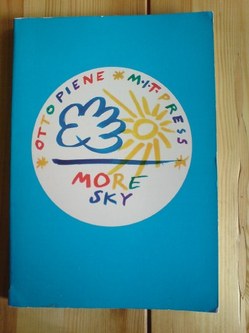 Alright, all y'all who didn't tell me about Otto Piene's classic of the books-written-in-longhand era, More Sky: what else have you been hiding?
Alright, all y'all who didn't tell me about Otto Piene's classic of the books-written-in-longhand era, More Sky: what else have you been hiding?
Otto Piene literally opens up new horizons here in both art and art education. His book is a plea for more scope, more space for art--for making public property artful and making art public property--for freeing the arts from the tight economic bonds that give the curators and the collectors a near monopoly. He writes, "The artist-planner is needed. He can make a playground out of a heap of bent cans, he can make a park out of a desert, he can make a paradise out of a wasteland, if he accepts the challenge.... In order to enable artists of the future to take on planning and shaping tasks on a large scale, art education has to change completely. At this point art schools are still training object-makers who are expecting museums and collectors to buy their stuff...."Otto Piene's More Sky is available the 1973 edition with the fun, blue cover, and a print-on-demand version with a boring black cover. So heads up when you buy. [amazon]The first part of More Sky covers "things to do" arranged alphabetically, A-M (Piene will take up N-Z some other time.) Like city planning, clothing, collaboration, electronic music, elements, engineering or government, graffiti, graphics, green toad jelly.
All these notes cohere into a larger statement in support of an environmental art for social use, the interaction of art and architecture and the city and the open landscape, a total ecological and elemental aesthetics.
The last part of the book, "Wind Manual," gives a practical demonstration of things to do in just one area. But it's a big one--the whole sky--and a lot can be done in it, making use of the wind; making human clouds, rain, rainbows; and making things that fly and float. This section is made up almost entirely of full-color illustrations of some of the things that man the artist can do to purify the skies polluted by man the money-maker and rendered fearsome by man the war-maker. The illustrations show different kinds of flags, banners, ribbons, wind socks, wind sculptures, riggings, kids and other things.
The first part was written plain, in the Spring of 1970, with no trace of artspeak jargon. And the second is plainly drawn and colored. (Piene is more versatile than most contemporary artists: he can do his abstract light-ballet things, and he can span rivers with man-made rainbows, and he can draw a recognizable picture of a bull.) The "Wind Manual" was originally drawn for instant use in schools and colleges in Pittsburgh--it was created as part of a Piene-guided public art project called Citything Sky Ballet.
The MIT Press
Massachusetts Institute of Technology
Cambridge, MA 02142












